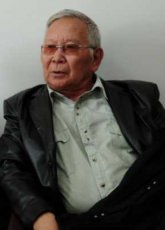|
 "I read recently that Astana historian Gizat Tabuldin says that he knows where Genghis Khan's grave is. But, as far as I know, it has not been found so far. It is also known that Tuvan scholar Nikolai Abayev has long been propagating the version that the tomb of the Shaker of the Universe is located in Tuva. It was in "Tuvinskaya pravda". So who is right?" (Sergei Kozlov, Kyzyl). "I read recently that Astana historian Gizat Tabuldin says that he knows where Genghis Khan's grave is. But, as far as I know, it has not been found so far. It is also known that Tuvan scholar Nikolai Abayev has long been propagating the version that the tomb of the Shaker of the Universe is located in Tuva. It was in "Tuvinskaya pravda". So who is right?" (Sergei Kozlov, Kyzyl).
We turned to Doctor of History, Professor of TGU Nikolai Abayev for a commentary.
- Gizat Tabuldin is a Kazakh scholar of great authority. He has dedicated many years to the study of the biography of the Shaker of the Universe. Recently he presented a substantial work on "World genealogy of the Genghisids", which shows the uninterrupted family tree of Temujin and his descendants from 13th to 21st century. Working on the book, Gizat Tabuldin and Anatoly Olovintsov studied the genealogy of more than 5000 representatives of the Genghisids: from great rulers to a simple nomad, from officials to the unemployed, from a baby to an aide of marshal Rokossovkiy.
The time period of the research, in which 170 historical sources were used, is 800 years. Authors of this book even received recognition by UNESCO and the USA Congress Library. And recently they were invited to participate in a scientific conference at Harvard.
In the words of Gizat Tabuldin, right now the 31st generation of Genghis Khan's descendants lives in Kazakhstan. Out of our contemporaries, members of this group include the famous journalist Rozlana Taukina, and the clairvoyant daughter of repressed historian Yermukhan Bekmakhanov, Nora Bekmakhanova. The genetic code of the Genghisid Y-chromosome is found in 16 Asian peoples.
Currently many scientists struggle with the mystery: so where is Genghis khan's tomb located? Professor of the geographic department of MGU told me in a private discussion that in 2009 Russians specially organized a secret expedition to search for Temujin's grave in Irkutsk region. Research showed that the tomb should be located on the bottom of one of the trans-border rivers, which flow over the territories of Mongolia, China and Russia. There is a version that the throne, given to Genghis Khan by his son Jochi should be there as well. As a matter of fact, it was confirmed by Mongolian Academy of Science that this expedition really was to take place.
However, my friend and colleague Gizat Zholdangarovich Tabuldin, with whom we presented at the last mongolist congress, was in too much of a hurry in determining the location of Genghis Khan's grave. It definitely cannot be in Irkutsk region, because it is the tribal territory of the Buryats, Mongolian Ekhrites, Bulagats, Onguts and Manguts, who joined Genghis Khan only in 13th century, and are relatives of the Taijiut tribe, from which the khan lineage Kiyat-Borjigin originated only in the female line. However, our research shows that the tomb should be located on the border between Tuva and Buryatia, where the Uriangkhai people live, who are senior relatives of Genghis Khan on both the male and female line. We wrote about this in a joint article with Mongush Baiyr-ool. Besides, the tribe of "forest Uriankats" (i.e. Todzhans), was a part of tribal federation of Taijiuts, who were also considered senior relatives of Genghis Khan. According to all calculations, the tomb should be in the least inaccessible place, where the ruler ordered one thousand Uriangkhai to guard his rest. We have already written about the fact that it was precisely the Uriangkhai Subedei who executed his last will.
|
|
